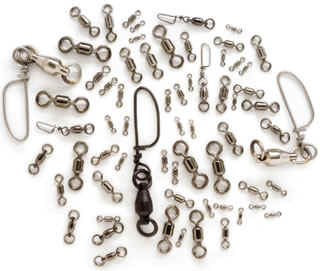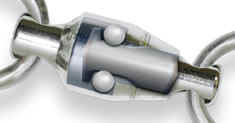Don’t overlook this small but vital link in your terminal-tackle chain.

As we covered in a previous column a few months back, line twist can become a serious problem if not kept in check. For example, it can lead to frustrating tangles, rob you of casting distance, and create weak spots in the line. While there are several ways to prevent line twist, one of the simplest is to use a swivel.
Swivels are snubbed by some light-tackle fishermen who believe they impede casting accuracy by preventing the lure or bait from being reeled to the rod tip prior to a cast. Some anglers also believe that swivels spook fish, or worse, look like a tasty tidbit to toothy critters, which could lead to a cut-off. However, thanks to new developments in swivels, these arguments don’t hold as much water as they once did.
Ball-Bearing Vs. Barrel
There are many types of swivels designed to match specific fishing applications. However, two basic designs cover most salt water needs: barrel and ball-bearing.
 Quality swivels are available in both ballbearing and barrel varieties for a huge range of fishing applications. |
The basic barrel swivel comprises a nickel-plated brass barrel that has been swaged around brass pins with formed heads and eyes. Barrel swivels are extremely popular due to their low cost and wide range of sizes. However, their biggest disadvantage is their inability to turn under heavy loads.
According to Brian Butts of Sampo, (315/896-2606;
Under minimal load, a barrel swivel should perform to spec. However, when sized inappropriately or subjected to heavy load (e.g., trolling deep-diving plugs, lengthy or repeated battles with big fish, soaking baits in a strong current), the friction within the swivel will slow or halt its rotation. When this happens, the swivel will fail to perform its job and allow twists to travel up the fishing line.
 This cutaway view of a ball-bearing swivel shows how the bearings are positioned to reduce friction. |
By comparison, a quality ball-bearing swivel contains polished stainless-steel ball bearings positioned between its spindle and body. This enables the swivel to rotate freely, negating any twist, even under heavy load. The perceived disadvantage of ball-bearing swivels is their price. However, in certain situations — especially offshore trolling — you can’t afford not to use them.
Construction and Finish
Most swivels are made of nickel-plated brass, with stainless-steel rings and snaps. Many anglers shy away from shiny swivels, fearing that a fish may mistake it for food and cut the line. However, I prefer a shiny, nickel-plated finish on my trolling swivels, for several reasons. To begin with, I’ve only been cut off once by a fish that attacked my swivel, and that occurred many years ago. However, I’ve lost two fish because of black snap swivels that broke during the fight.
According to Sampo’s Brian Butts, in order to make a nickel-plated swivel black, the swivel must to go back in the plating line to coat the stainless-steel rings and snaps with more nickel. The swivel is then plated with copper and dipped in a salt bath to oxidize the copper, which turns it black. This process tends to eat away at the brass, especially if any salt becomes lodged inside the swivel. If you’re unfortunate enough to get that rare bad swivel, it could cost you a fish.
 Some anglers swear by black swivels, while others, including the author, prefer a shiny finish. |
Selecting the right swivel hinges largely on how you’ll be fishing. For offshore trolling, I use ball-bearing snap swivels exclusively. As mentioned, their friction-free performance prevents line twist at all trolling speeds and when fighting fish.
For serious trolling, I believe it’s critical for the snap swivel to feature welded rings on each end. With this style, the fishing line (or wind-on leader) is secured to one ring, while the snap is attached to the opposite ring. On some snap swivels, the snap is simply affixed through a hole in the lower base of the swivel, as shown. Double rings give the swivel more latitude to rotate and stay in balance, eliminating any resistance that could lead to line twist.
As far as choosing the right size of trolling swivel, the standard theory is to use one that’s slightly heavier than the leader. I go a bit heavier than that. While using a swivel that’s just large enough to get the job done has merit, such as being less visible and posing less of a temptation to other fish, I prefer to step it up a bit. For example, on 50-pound-class trolling gear (especially in conjunction with a 100- to 130-pound-test wind-on leader), I use a No. 6, or 200-pound-test, ball-bearing snap swivel. I upgrade to this size to counter the additional pressure that can be applied once the wind-on leader has been wound onto the reel, or when the leader or swivel is grabbed to wire a fish. Should the fish surge while the wireman is still holding the leader, the swivel or its snap won’t fail. Furthermore, the larger swivel is even more efficient in countering line twist, and I actually like the extra commotion it makes on the troll — I believe it enhances the trolling illusion by making it seem as if my baits or lures are chasing down smaller prey. In keeping with my theory, I’ll use a No. 4 (100-pound test) swivel on my 20-pound trolling outfits, a No. 5 (165-pound test) on my 30-pound outfits, and a No. 8 (300-pound test) on my 80-pound outfits.
Extreme Swivels
Once used mainly by commercial fishermen, “Australian-style” swivels are now widely available. These streamlined, torpedo-shaped swivels are designed for extreme, heavy-tackle fishing, in situations that may tax other swivels. This includes fishing for giant tuna, as well as trolling or chunking for big yellowfins and bluefins, drifting for swordfish and trolling or live-baiting for big blue marlin.
 The author considers welded rings a must on heavy-duty swivels, but prefers those with rings on either end. |
According to John Hargaden at Rite Angler (954/491-8562;
The Aussie Swivels by Rite Angler range from 300- to 900-pound test and sell for approximately twice the price of comparable ball-bearing swivels. They are typically used for connecting a heavy wind-on leader to a short leader, connecting heavy braid or monofilament to heavy leaders, and wire-line trolling.
Finesse Swivels
The SPRO Corporation (770/919-1722;
 Anglers use tiny SPRO Power Swivels to connect the sections in a low-visibility terminal-gear set-up. |
According to Paul Michele, SPRO’s Eastern Regional Sales Manager, the Power Swivel was inspired by the “finesse-fishing” craze, where anglers continue to scale down their tackle to fool more fish. “Our Power Swivels are low-profile and super-strong,” says Michele. “They complement the low-vis terminal-gear approach, where fluorocarbon leaders and small hooks are now the norm. The most popular applications for this swivel as of late have been for connecting super braid to fluorocarbon leaders for striped bass, snook and tarpon; monofilament line to fluorocarbon leaders for tuna chunking; and fluorocarbon or monofilament to light-wire leaders for live-bait king mackerel fishing.”
Although Michele was elusive in revealing the secret that enables SPRO to make such strong swivels in such remarkably small sizes, he did say that high-quality stainless steel is part of the equation. These swivels are so compact that some anglers have been using them to build wind-on leaders on 30- and 50-pound-class trolling tackle, as the low-profile swivels pass through the guides and onto the reel with relative ease.
The tiny Power Swivels also allow light-tackle anglers to reel the bait or lure right to the rod tip when casting accuracy is an issue. They track through the water quietly and are far less visible than larger swivels, too. In short, they are proving to be just the ticket for avoiding line twist when repeatedly casting lures and baits on light tackle, drifting live baits, and free-lining baits in a chum slick.
When it comes to sizing the Power Swivels, and all barrel swivels in general, match them to the strength of the leader you’re using. If you’re not stealth fishing and can get away with a slightly stronger and larger swivel than your leader, you’ll get that much more insurance against line twist.
Swivel TLC
Because they’re not a prominent piece of tackle, swivels are easily neglected. But it’s important to rinse them thoroughly when cleaning your tackle, inspect them for damage and make sure they rotate freely. This is especially important after fighting a large fish.
Finally, keep in mind that swivels get tired over time. Replace them periodically, even if they appear to be fine. Doing so will guarantee that they’ll do their job and hold together when you need them most. In addition, they’ll make sure line twist remains a headache of the past!

